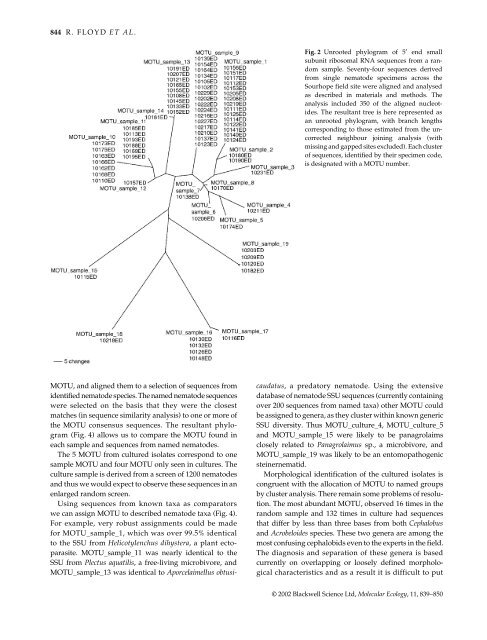Molecular barcodes for soil nematode identification - Bolinfonet.org
Molecular barcodes for soil nematode identification - Bolinfonet.org
Molecular barcodes for soil nematode identification - Bolinfonet.org
Create successful ePaper yourself
Turn your PDF publications into a flip-book with our unique Google optimized e-Paper software.
844 R. FLOYD ET AL.<br />
MOTU, and aligned them to a selection of sequences from<br />
identified <strong>nematode</strong> species. The named <strong>nematode</strong> sequences<br />
were selected on the basis that they were the closest<br />
matches (in sequence similarity analysis) to one or more of<br />
the MOTU consensus sequences. The resultant phylogram<br />
(Fig. 4) allows us to compare the MOTU found in<br />
each sample and sequences from named <strong>nematode</strong>s.<br />
The 5 MOTU from cultured isolates correspond to one<br />
sample MOTU and four MOTU only seen in cultures. The<br />
culture sample is derived from a screen of 1200 <strong>nematode</strong>s<br />
and thus we would expect to observe these sequences in an<br />
enlarged random screen.<br />
Using sequences from known taxa as comparators<br />
we can assign MOTU to described <strong>nematode</strong> taxa (Fig. 4).<br />
For example, very robust assignments could be made<br />
<strong>for</strong> MOTU_sample_1, which was over 99.5% identical<br />
to the SSU from Helicotylenchus dihystera, a plant ectoparasite.<br />
MOTU_sample_11 was nearly identical to the<br />
SSU from Plectus aquatilis, a free-living microbivore, and<br />
MOTU_sample_13 was identical to Aporcelaimellus obtusi-<br />
Fig. 2 Unrooted phylogram of 5′ end small<br />
subunit ribosomal RNA sequences from a random<br />
sample. Seventy-four sequences derived<br />
from single <strong>nematode</strong> specimens across the<br />
Sourhope field site were aligned and analysed<br />
as described in materials and methods. The<br />
analysis included 350 of the aligned nucleotides.<br />
The resultant tree is here represented as<br />
an unrooted phylogram, with branch lengths<br />
corresponding to those estimated from the uncorrected<br />
neighbour joining analysis (with<br />
missing and gapped sites excluded). Each cluster<br />
of sequences, identified by their specimen code,<br />
is designated with a MOTU number.<br />
caudatus, a predatory <strong>nematode</strong>. Using the extensive<br />
database of <strong>nematode</strong> SSU sequences (currently containing<br />
over 200 sequences from named taxa) other MOTU could<br />
be assigned to genera, as they cluster within known generic<br />
SSU diversity. Thus MOTU_culture_4, MOTU_culture_5<br />
and MOTU_sample_15 were likely to be panagrolaims<br />
closely related to Panagrolaimus sp., a microbivore, and<br />
MOTU_sample_19 was likely to be an entomopathogenic<br />
steinernematid.<br />
Morphological <strong>identification</strong> of the cultured isolates is<br />
congruent with the allocation of MOTU to named groups<br />
by cluster analysis. There remain some problems of resolution.<br />
The most abundant MOTU, observed 16 times in the<br />
random sample and 132 times in culture had sequences<br />
that differ by less than three bases from both Cephalobus<br />
and Acrobeloides species. These two genera are among the<br />
most confusing cephalobids even to the experts in the field.<br />
The diagnosis and separation of these genera is based<br />
currently on overlapping or loosely defined morphological<br />
characteristics and as a result it is difficult to put<br />
© 2002 Blackwell Science Ltd, <strong>Molecular</strong> Ecology, 11, 839–850



